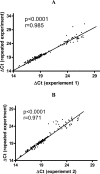Altered gene expression by low-dose arsenic exposure in humans and cultured cardiomyocytes: assessment by real-time PCR arrays
- PMID: 21776218
- PMCID: PMC3138013
- DOI: 10.3390/ijerph8062090
Altered gene expression by low-dose arsenic exposure in humans and cultured cardiomyocytes: assessment by real-time PCR arrays
Abstract
Chronic arsenic exposure results in higher risk of skin, lung, and bladder cancer, as well as cardiovascular disease and diabetes. The purpose of this study was to investigate the effects on expression of selected genes in the blood lymphocytes from 159 people exposed chronically to arsenic in their drinking water using a novel RT-PCR TaqMan low-density array (TLDA). We found that expression of tumor necrosis factor-α (TNF-α), which activates both inflammation and NF-κB-dependent survival pathways, was strongly associated with water and urinary arsenic levels. Expression of KCNA5, which encodes a potassium ion channel protein, was positively associated with water and toe nail arsenic levels. Expression of 2 and 11 genes were positively associated with nail and urinary arsenic, respectively. Because arsenic exposure has been reported to be associated with long QT intervals and vascular disease in humans, we also used this TLDA for analysis of gene expression in human cardiomyocytes exposed to arsenic in vitro. Expression of the ion-channel genes CACNA1, KCNH2, KCNQ1 and KCNE1 were down-regulated by 1-μM arsenic. Alteration of some common pathways, including those involved in oxidative stress, inflammatory signaling, and ion-channel function, may underlay the seemingly disparate array of arsenic-associated diseases, such as cancer, cardiovascular disease, and diabetes.
Keywords: arsenic; cardiomycocytes; drinking water; low-density array; real-time PCR.
Figures




Similar articles
-
Sex-specific patterns and deregulation of endocrine pathways in the gene expression profiles of Bangladeshi adults exposed to arsenic contaminated drinking water.Toxicol Appl Pharmacol. 2015 May 1;284(3):330-8. doi: 10.1016/j.taap.2015.02.025. Epub 2015 Mar 7. Toxicol Appl Pharmacol. 2015. PMID: 25759245 Free PMC article.
-
Gene expression of inflammatory molecules in circulating lymphocytes from arsenic-exposed human subjects.Environ Health Perspect. 2003 Aug;111(11):1429-38. doi: 10.1289/ehp.6396. Environ Health Perspect. 2003. PMID: 12928151 Free PMC article.
-
Drinking-water arsenic exposure modulates gene expression in human lymphocytes from a U.S. population.Environ Health Perspect. 2008 Apr;116(4):524-31. doi: 10.1289/ehp.10861. Environ Health Perspect. 2008. PMID: 18414638 Free PMC article.
-
Chronic health effects in people exposed to arsenic via the drinking water: dose-response relationships in review.Toxicol Appl Pharmacol. 2004 Aug 1;198(3):243-52. doi: 10.1016/j.taap.2003.10.022. Toxicol Appl Pharmacol. 2004. PMID: 15276403 Review.
-
Arsenic exposure and bladder cancer: quantitative assessment of studies in human populations to detect risks at low doses.Toxicology. 2014 Mar 20;317:17-30. doi: 10.1016/j.tox.2014.01.004. Epub 2014 Jan 21. Toxicology. 2014. PMID: 24462659 Review.
Cited by
-
Concurrent Heavy Metal Exposures and Idiopathic Dilated Cardiomyopathy: A Case-Control Study from the Katanga Mining Area of the Democratic Republic of Congo.Int J Environ Res Public Health. 2021 May 6;18(9):4956. doi: 10.3390/ijerph18094956. Int J Environ Res Public Health. 2021. PMID: 34066615 Free PMC article.
-
Urine Arsenic and Arsenic Metabolites in U.S. Adults and Biomarkers of Inflammation, Oxidative Stress, and Endothelial Dysfunction: A Cross-Sectional Study.Environ Health Perspect. 2017 Dec 15;125(12):127002. doi: 10.1289/EHP2062. Environ Health Perspect. 2017. PMID: 29373859 Free PMC article.
-
Recruitment of normal stem cells to an oncogenic phenotype by noncontiguous carcinogen-transformed epithelia depends on the transforming carcinogen.Environ Health Perspect. 2013 Aug;121(8):944-50. doi: 10.1289/ehp.1306714. Epub 2013 May 17. Environ Health Perspect. 2013. PMID: 23687063 Free PMC article.
-
hERG channel function: beyond long QT.Acta Pharmacol Sin. 2013 Mar;34(3):329-35. doi: 10.1038/aps.2013.6. Acta Pharmacol Sin. 2013. PMID: 23459091 Free PMC article. Review.
-
A distinct and replicable variant of the squamous cell carcinoma gene inositol polyphosphate-5-phosphatase modifies the susceptibility of arsenic-associated skin lesions in Bangladesh.Cancer. 2015 Jul 1;121(13):2222-9. doi: 10.1002/cncr.29291. Epub 2015 Mar 10. Cancer. 2015. PMID: 25759212 Free PMC article.
References
-
- Tapio S, Grosche B. Arsenic in the aetiology of cancer. Mutat. Res. 2006;612:215–246. - PubMed
-
- Straif K, Benbrahim-Tallaa L, Baan R, Grosse Y, Secretan B, El Ghissassi F, Bouvard V, Guha N, Freeman C, Galichet L, et al. A review of human carcinogens—Part C: Metals, arsenic, dusts, and fibres. Lancet Oncol. 2009;10:453–454. - PubMed
-
- Rossman TG, Uddin AN, Burns FJ. Evidence that arsenite acts as a cocarcinogen in skin cancer. Toxicol. Appl. Pharmacol. 2004;198:394–404. - PubMed
MeSH terms
Substances
LinkOut - more resources
Full Text Sources
Medical

